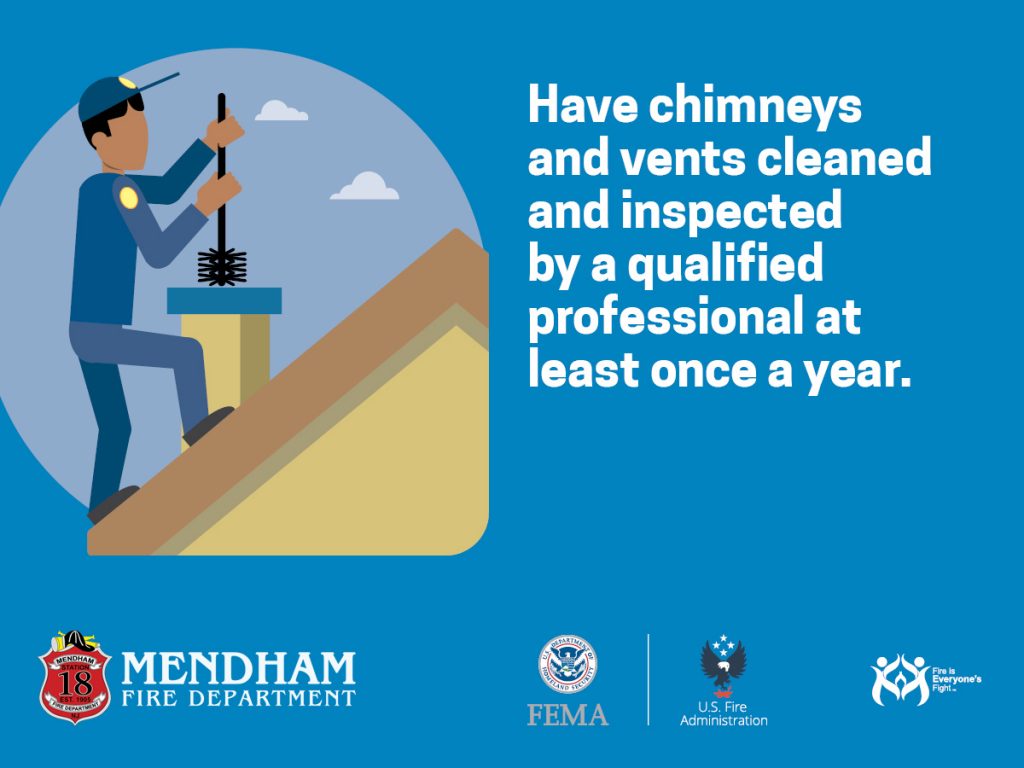A resident recently asked “How often should wood burning fireplaces be inspected and cleaned?” A great question considering many in our community have wood-burning fireplaces in their homes—there is even one in our firehouse—so we are sharing the response from our Fire Official, Craig Bellamy.
Chapter 14 of NFPA 211 provides maintenance standards for chimneys, fireplaces and vents. The standards shed light on several important points. Here are a few examples:
- Clearances around chimneys, fireplaces and vents must remain unobstructed.
- Annual inspections provide early detection of problems that could cause fires, carbon monoxide poisoning or structural deterioration.
- If an inspection reveals that the chimney or vent installation is unsuitable for any reason, the installation needs to be redone to fit the standards. This may mean installing a larger chimney or correcting construction to meet clearance requirements.
NFPA 211 has effectively taken discretion out of the equation by defining three levels of inspection service that a certified chimney professional will provide. Whether a Level 1, 2 or 3 inspection should be made is determined in each case depending on the type and condition of the fireplace and heating appliances, their frequency of use, the chimney system in place, appliance connections to the venting system, and other specific factors. The following information explains what each inspection level involves and the services the chimney professional should perform for each level.
Level 1: This is the minimum required inspection performed when there have been no changes or modifications to your fireplace, heating appliances or chimney and you intend to continually use the system in the same way as you’ve always done. For example, if you aren’t planning to convert your wood burning fireplace to a pellet stove insert or change from an oil furnace to a natural gas furnace, then a Level 1 chimney system inspection would be recommended.During a Level 1 inspection the chimney professional will evaluate the readily accessible inside and outside areas of the chimney as well as the accessible parts of the fireplace and heating appliance and the connections to the chimney. The professional will inspect the structural integrity of the fireplace, chimney and flue liner and check that all heating appliances are installed and connected properly to assure safe operation and venting. He or she will confirm whether there are any combustibles in the flue such as animal nests, debris and creosote deposits and clean the chimney accordingly if present.
Level 2: This chimney inspection is more involved than a Level 1 and it is necessary whenever changes are planned or have been made to any part of the system. Examples of such changes would be an insert installation into a fireplace or the replacement of an old boiler with a new, high efficiency unit. A Level 2 inspection is also required if:
The property is being sold or transferred to a new owner.
The house or chimney footing has settled over time causing noticeable cracks or other damage to the chimney masonry.
There has been a chimney fire, a partial house fire, a weather event, etc. which could have damaged the chimney. In the course of a Level 2 inspection the accessible parts of the chimney and the surrounding structure i.e., attic, roof, crawl spaces and basements, will be checked thoroughly for soundness and building code compliance. While access to certain parts of the chimney, the building and heating appliances will require the use of small tools, Level 2 does not involve any permanent removal or destruction of any part of the chimney, wall finishes or building structure to complete the inspection. This is primarily a visual inspection of the outside and inside of the chimney system which will include the use of a video camera to examine the clay or metal flue liner and brick fire shelf of masonry chimneys or interior structures of prefabricated chimney systems.
Level 3: A Level 3 inspection is required when either a Level 1 or 2 inspection raises valid suspicions that inaccessible or hidden parts of the chimney system or nearby walls are concealing a fire hazard or out of code installation. In order to gain access to specific hidden areas that are the subject of a Level 3 inspection it may be required to remove or destroy some of sections of the chimney, building structure or nearby finished walls. This inspection level is the most expensive to have done and will usually require costly post-inspection repairs to the chimney and surrounding area.
The purpose of NFPA 211 is to help assure the safety of your family and to protect your property from a serious fire hazard.

Simply put, have your chimney inspected and if necessary cleaned annually. However if a chimney fire has occurred, extreme heat may have caused damage that cannot be seen with the naked eye. An inspection of the entire chimney, both interior and exterior, is the only way to ensure safe use in the future and MUST be completed by a certified chimney professional.
New Jersey state law now requires that Carbon Monoxide (CO) Alarms be installed in all occupies that have fuel burning appliances and/or attached garages. For your family’s safety please install them if you do not have them. Mendham fire department, over recent years have responded to several CO incidents where if the occupancy did not have a CO Alarm to warn them serious illness or death would have occurred.
Resources
NFPA 211 & Your Chimney: chimneys.com/articles/nfpa-211-your-chimney
About Mendham Facebook Group: Neighbors have recommended a number of area sweeps and service provides from the area within the “About Mendham” Facebook Group. Follow this link to view the posts regarding chimney seeps & repair companies. Note: You must be a member of the group to view the posts.
Mendham Borough Fire Official’s Website: mendhamfireprevention.org – Note: The fire official’s office does not perform general chimney inspections.

